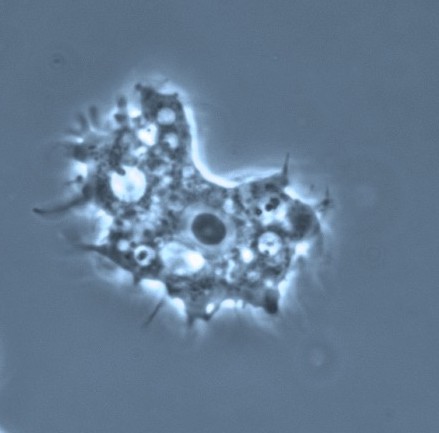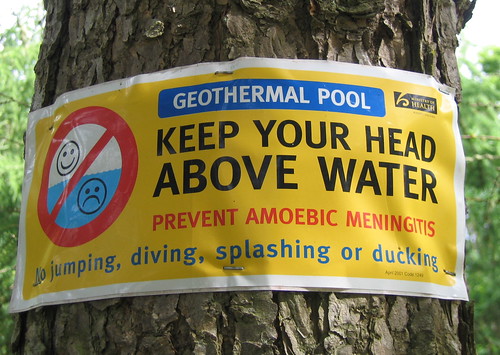 Ok - I confess. There's only one reason this parasite is even remotely sci-fi worthy. Though, to be fair, it's a pretty good one: it kills you by eating your brains.
Ok - I confess. There's only one reason this parasite is even remotely sci-fi worthy. Though, to be fair, it's a pretty good one: it kills you by eating your brains.
Meet Naegleria fowleri. A happy, free-living protist that lives in warm fresh water - at least until a very unlucky person dunks their head in it.
Naegleria has three stages of its life: a flagellate, and amoeba, and a cyst. In the water, it is in its infectious, flagellate form called a "trophozoite". It reproduces asexually, and swims around quite happily if the water is fresh and warm (over 75 degrees). If conditions are poor, the little amoeba will encyst, creating a round, hard casing which survives extreme conditions. When conditions become better, it reverts in minutes back to its happy, flagellated self.
.png) But, of course, they're even happier when a person sticks their head under that nice, warm water. The trophozoite swims up the nasal cavity and enters the olfactory mucosa and nasal tissues. At first, this just destroys the person's olfactory bulbs. But the parasite isn't done yet - it travels along the nerve fibers through to the brain itself. It sheds its flagellum and switches to its amoeba stage - a slow, single-celled organism that divides like crazy. If returned to the water somehow, it would switch right back to having a flagellum. But in the meantime it divides, creating a colony of amoebas in your brain.
But, of course, they're even happier when a person sticks their head under that nice, warm water. The trophozoite swims up the nasal cavity and enters the olfactory mucosa and nasal tissues. At first, this just destroys the person's olfactory bulbs. But the parasite isn't done yet - it travels along the nerve fibers through to the brain itself. It sheds its flagellum and switches to its amoeba stage - a slow, single-celled organism that divides like crazy. If returned to the water somehow, it would switch right back to having a flagellum. But in the meantime it divides, creating a colony of amoebas in your brain.
 Infection with Naegleria causes the disease primary amebic meningoencephalitis. Part of the disease is caused by the parasite's mere presence and the body's immune reaction to it. But more of the damage is caused by the amoebas chowing down on the neurons themselves. Naegleria have special surface proteins which act like a chain saw, cutting holes in the neuron's cellular membranes. The neuron's contents then spill out, and all the nutrients and proteins are happily slurped up by the waiting amoeba. Other cell-surface proteins of the amoeba allow it to find the most vulnerable areas on the neuron's outer membrane and, after attacking, detect where the nutrients are so it can move towards them.
Infection with Naegleria causes the disease primary amebic meningoencephalitis. Part of the disease is caused by the parasite's mere presence and the body's immune reaction to it. But more of the damage is caused by the amoebas chowing down on the neurons themselves. Naegleria have special surface proteins which act like a chain saw, cutting holes in the neuron's cellular membranes. The neuron's contents then spill out, and all the nutrients and proteins are happily slurped up by the waiting amoeba. Other cell-surface proteins of the amoeba allow it to find the most vulnerable areas on the neuron's outer membrane and, after attacking, detect where the nutrients are so it can move towards them.
At first, changes in sense of taste or smell or severe nasal infections are the only warning of the sinister parasite lurking within. These are followed by symptoms similar to bacterial meningitis - fever, stiff neck, etc. As time wears on, usually 1-3 days later, someone infected with Naegleria might be easily confused, lose ability to focus, lose their balance, have seizures and even hallucinate. Death almost always follows within 3-7 days.
Cures to Naegleria haven't been developed yet, as it has the nasty habit of changing its protein coat whenever something targets it. That's how it evades the immune system, too - that, and it can steal proteins that it eats to place on its membrane, essentially fooling the immune cells into believing its one of our own cells. That, and of course, how quickly people die from it. But, luckily, infections are fairly rare, despite how widely-dispersed and common the parasite is. Part of this is likely due to the fact that it can't be spread person-to-person directly... yet.
 The parasite thrives when the temperature heats up - preferring a nice, steaming bath of around 95 degrees. It's no surprise, then, that infections are most common in the summer months. It does make you think, though - if temperatures start to rise throughout the world, will Naegleria infections rise, too?
The parasite thrives when the temperature heats up - preferring a nice, steaming bath of around 95 degrees. It's no surprise, then, that infections are most common in the summer months. It does make you think, though - if temperatures start to rise throughout the world, will Naegleria infections rise, too?
That's the last thing we need - more zombie-wannabe amoebas. Now if that's not incentive to cut carbon emissions, I don't know what is.

Te escribo desde Lima en Peru. Donde las enfermedades tropicales abundan jaja es la primera vez que leo algo tan gracioso y con tanta informacion, Me gusto mucho lo que hiciste y pues me diste la idea de copiarte, jeje estudio medicina en Lima y tambien es la primera vez que escribo tan agradecido y tambien que escribo en un idioma que no es el natural de mi receptor, pero sorry mi ingles en gramatica es un asco y no creo q lo entiendas ajjaja. Exitos y gracias por compartir informacion. Como llegue a escribirte y leer el blog.. fue por buscar una imagen de la Naegleria! Saludos desde Lima.
maa chodamnav kaink saru update karo nakar site bandh kari dyo etle kok bija sari site khole.
Thanks Christie, so much, for a very interesting article about global warming new diseases.I will be careful about it. Have a great weekend, since lima peru, your new friend David